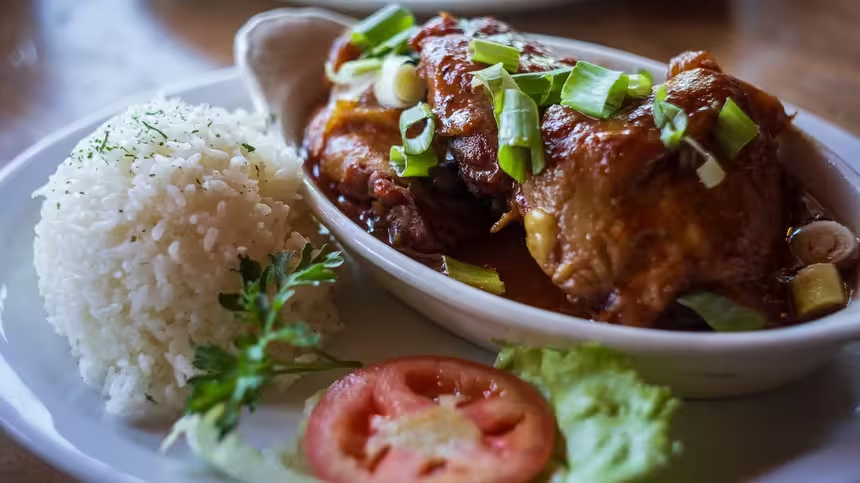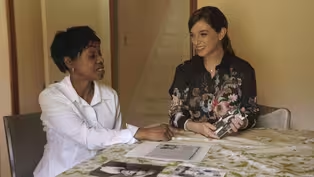
The Indigenous Fashion Movement
Clip: Episode 3 | 6m 33sVideo has Closed Captions
In Calgary, Pati Jinich meets leaders of the rising Indigenous Fashion movement.
Indigenous fashion is rising, and it’s more than style. It's story. In Calgary, Pati Jinich speaks with Chelsa Racette (Founder of Indigenous Fashion Week), Kim Coltman (Producer, Indigenous Fashion Week), and Tyson Martell (Model & Actor) to explore how indigenous fashion is reshaping the industry, reclaiming space, and creating new opportunities for indigenous creatives.
Problems playing video? | Closed Captioning Feedback
Problems playing video? | Closed Captioning Feedback
Support for PATI JINICH EXPLORES PANAMERICANA is provided by Marriott International, La Costeña, Texas A&M International University, Visit Anchorage, Travel Juneau, Travel Yukon, and Chicanos Por La Causa.

The Indigenous Fashion Movement
Clip: Episode 3 | 6m 33sVideo has Closed Captions
Indigenous fashion is rising, and it’s more than style. It's story. In Calgary, Pati Jinich speaks with Chelsa Racette (Founder of Indigenous Fashion Week), Kim Coltman (Producer, Indigenous Fashion Week), and Tyson Martell (Model & Actor) to explore how indigenous fashion is reshaping the industry, reclaiming space, and creating new opportunities for indigenous creatives.
Problems playing video? | Closed Captioning Feedback
How to Watch Pati Jinich Explores Panamericana
Pati Jinich Explores Panamericana is available to stream on pbs.org and the free PBS App, available on iPhone, Apple TV, Android TV, Android smartphones, Amazon Fire TV, Amazon Fire Tablet, Roku, Samsung Smart TV, and Vizio.
Buy Now

The Pati Jinich Recipe Collection
Find Pati Jinich recipes from this series and more on PBS Food.Providing Support for PBS.org
Learn Moreabout PBS online sponsorshipThe city of Calgary in Alberta, Canada was built on ancestral lands where the Bow and Elbow Rivers have long been a gathering place for indigenous nations.
Today, it's a gathering place for a modern movement, indigenous fashion.
So can you repeat all of the steps super quick before we start.
So watch your posture, check your posture, shoulders back and down, chin up, ears in line with your shoulders, shoulder in line with your hip, hip in line with your knees, knee in line with your ankle.
And then you're going to, from stance position, which is a your base foot is at a 45-degree angle.
Your lead foot is pointing straight ahead and you're going to walk.
Start with your lead foot at all times.
This one.
And you're going to walk toe to heel.
Okay.
Ready?
And 3, 2, 1.
Oh my gosh.
I'm horrible at this.
I can't, I can't do toe to heel.
And make sure you're always at 90 because you got photographers coming at you.
- I'm like crashing into you, crashing into you.
I'm ready for Paris.
Here we come!
Chelsa Racette kicked it off in 2012 when she founded Indigenous Fashion Week.
You guys, I'm so excited to be here talking with you and with this view.
So you brought me this, which is so incredible.
You were just at, the fashion fair in Paris, and I was just reading about your statement, and it says, “Indigenous fashion is a form of art and self-expression.
It's about telling stories about our ancestors passing thousands of years of traditions on.
We're taking up spaces where we were not allowed 50 plus years ago.” That just made me shiver.
Tell me, tell me about this movement.
It's, you know, it's a movement about showing people that we're here, were people, were human beings We're not this Hollywood stereotypical native person.
Right?
We're breaking barriers, breaking boundaries, and stepping into the mainstream fashion industry.
It's also about creating equal opportunities, both economically and in the fashion industry, where previously we weren't allowed.
You're a model?
I was, yes.
You were a model.
I started off modeling, yes.
You started off modeling and then you created a model agency?
Yes.
We had a modeling agency.
Tell me about the concept.
Well, I started off modeling.
I was in shows all across Canada and the States, and I just, I found that we weren't being represented to the full extent that we should have been.
Right?
So I started a modeling agency, and then I started doing fashion shows and all the network that I created, I just utilized it and put it together and put one big show on.
And that was 2012 was our first Indigenous Fashion Week.
I've been a fashion model since 1972 and when I initially started modeling, they never referred to me by my name.
I was known as “the Indian,” which was derogatory in many ways, but I'm glad that I stuck with it, despite that, because now we're able to open doors for so many more Indigenous peoples moving forward, whether they be fashion designers, models, makeup artists, hairstylists, photographers, everybody, we want to bring them all with us.
So you were placed in a box, and now you're taking that box out into the world and the mainstream and taking up space Yeah.
where you belong.
- Yes.
And what have been, do you feel the biggest obstacles?
Opportunity and access.
Those were the biggest obstacles that I found in terms of being able to start my company.
And then when I met Chelsa, and then she introduced me to Tyson.
So we all started working together and pooling our resources and our skills.
And I think that that's what's been able to allow us to move forward and to bring so many others with us.
So, it is I am not the Indigenous model, I'm a model.
But I'm bringing everything I have to that space.
We now have access to more designers and models than ever before.
And when they come to us and they learn from Tyson and they learn from Chelsea and they they learn from me, they learn that it's okay to be Indigenous now.
You don't have to be ashamed or afraid of it anymore.
Growing up, I was not allowed to say that I was Indigenous.
The one and only time in my life my grandmother hit me was because I went to learn how to powwow dance.
You had to hide?
We had to hide.
And we don't have to anymore.
I'll do a warrior call.
Yes.
So, It's loud.
That's so powerful.
We also do smudging like, Tyson will facilitate a fudge, not a fudge, before all of our shows.
- What's smudging?
It's, a way for, - To cleanse.
us to cleanse and to ground ourselves before we go out there and, and present clothing to people who are non-indigenous.
We stink to spirit because all that lotions and perfumes and stuff we put on.
Yeah.
What smudging does is it allows our, our ancestors and our, our guides and angels to come sit with us because we stink to them.
You know?
Yes.
So, okay, well now they smell like plants and herbs and well come sit and talk to them.
You guys share so much, and when you come to DC or to Mexico, if I'm there, I will share so much, too.
That will be fabulous.
We can set up a fashion show.
Exactly.
Let's do it.
And you're going to model for us.
I don't know if I'm a good model but I can pretend.
Exactly.
I'm still doing that.
I still get criticized for walking like a duck.
That could be your signature walk.
Embrace it.
Video has Closed Captions
Clip: Ep3 | 6m 30s | Pati Jinich visits the town of Wildwood, founded by Canada’s early black settlers. (6m 30s)
Canada’s Wildest Caesar Cocktail
Video has Closed Captions
Clip: Ep3 | 2m 58s | Pati Jinich visits Big Sky BBQ in Alberta to try their legendary Barbecue King Caesar. (2m 58s)
Providing Support for PBS.org
Learn Moreabout PBS online sponsorshipSupport for PBS provided by:





















